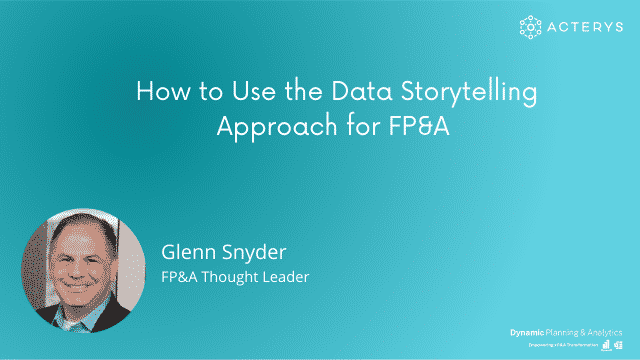
Table of Contents
For every organization, FP&A mandates professionals to have first-rate analytical thinking and numerical analysis skills to interpret financial data and produce insights surrounding business performance. However, crunching numbers and compiling insights is only the first part of the process. To paint the complete picture, they need to understand how those disjointed figures come together and put them in a cohesive narrative to effectively translate insights into game-changing decisions and real-world actions.
So how can finance leaders take fragments of data from across the organization and weave them into an FP&A success story?
We recently had the pleasure to chat with Glenn Snyder on how FP&A leaders can use the data storytelling approach to tell the meaning behind numbers and answer critical business questions that pave the way to drive revenue and growth.
Glenn is an FP&A thought leader with a combined 26 years of experience under his belt of driving corporate strategy and FP&A verticals. Currently the VP of FP&A at Zazzle, Glenn has established and led FP&A departments of several big public companies, such as Franklin Templeton, Visa, and Charles Schwab, and a few private companies, which speaks volumes of his sheer knowledge of the industry.
Check out what he has to say about using the data storytelling approach for FP&A success.
What is Data Storytelling for FP&A?
Data storytelling in FP&A is the process of using financial and business data to create a compelling narrative that explains trends, insights, and the underlying reasons behind numerical changes. It involves translating complex data into a clear, engaging, and actionable story that aids decision-making and drives business growth.
What are the key elements of the data storytelling approach with respect to FP&A?
Storytelling is just like when you read a novel. You’ve got to start off with the introduction of what you are doing and who are your characters. Then take them through the arc and come to the conclusion.
Many times when FP&A fails to tell a good story, it is because they are only staying within the financial numbers i.e. revenues and expenses, showing this went up and that went down. It’s sometimes referred to as elevator analysis. It doesn’t really tell you much because you can look at the data itself and come to the same conclusion. But where FP&A can succeed in storytelling is to look at the underlying business metrics.
Why did this go up? What’s going on behind the data? Because, as an example, revenue doesn’t grow by itself.
You can say revenue went up 10%. But why? You could have had more clients, launched a new product, gone into a new market, or run an advertising campaign. Whatever it happens to be, there is a reason behind the numbers going up – that’s where the story sits.
So you have to start with: what are the business drivers and how do they connect to the financials?… And that’s where the heart of the story is.
[ctabutton title=”Need Tailored Reporting, Planning & Analytics Solutions?” content=”Talk to our solution experts now” button=”Book a Meeting” url=”https://acterys.com/book-a-meeting/”]
What do FP&A managers and CFOs need to tell the data-driven story?
First of all, you need data that connects to each other. Whether you are working in Excel or using a system, you need to understand how your client data flows with the product data and connects with your financial data. But all of that usually happens in the background. FP&A professionals generally start in Excel but then they move it into a more robust solution because they want to automate those data connections.
With that said, you also need to have that trust and understanding with the business. I have never seen FP&A leaders tell a good story without having a very strong relationship with business partners. FP&A should meet with them on a monthly basis and talk not just about what Finance needs but also what their needs, strategies, and goals are. Because if you don’t understand what’s going on in the business, how can you tell that story and tie it back to the financials?
FP&A is a unique area that touches every aspect of the company and every business leader at any time. If you stay only on the financial side and look at what’s going on with the revenues, or how you are doing against the budget, expenses or headcount, you are going to miss the story.
It is recommended to have regular meetings with your head of operations, head of sales, director of marketing and other key personnel and talk to them about what they are trying to do with the business. Look at the results they are generating and how that ties back to the financial results that you are seeing. And when you connect the two, you tell a much better story.
And that’s where it really needs to begin from an FP&A organization standpoint.
How does data storytelling help FP&A teams translate insights into real-world actions?
You need to keep in mind that Finance doesn’t drive the company. And if you think otherwise, unfortunately, you have a wrong perception.
Finance is there to help business leaders drive the company. Finance doesn’t generate new customers, create products, or enter new markets. That’s what the business is out there to do. So, you have to make sure that you are building trust and relationships with those leaders and gathering perspectives and information about their functional areas.
Now when it comes to storytelling, that’s where you combine the business knowledge with finance knowledge. You put all of it together and tell the story in a very sharp, concise way.
The number one thing you’ll have to remember is: be unbiased. Try and avoid judgmental language, like they did a great job, or they underperformed, or they did a poor job. You don’t want to make judgments in your analysis. For example, revenues grew by 20% because of a promotion that marketing ran last week, and it directly tied to a 15% revenue increase of this product. That is factual.
Don’t say, “Marketing did a great job because we saw a 20% revenue increase.” Avoid all of the contextual arguments and keep it fact based. There should be no room for dispute in your statements because the second you start putting your own judgment in them, you lose credibility.
Hence, my number one advice is just to keep it to the facts.
How do FP&A leaders convey the right message to respective stakeholders through this storytelling approach?
Building upon my last answer about keeping things fact-based, I think it is not just about what the content is, sometimes it is about the presentation as well.
So when you’re trying to tell your story to stakeholders, yes, you have to have the information, but you have to present it in the right way as well. I would recommend that you should keep it short and to the point – don’t write pages or paragraphs. Instead, just keep nice short sentences or even phrases in bullet points.
You could use data tables, but keep in mind that some aren’t always numbers people. And depending on the audience, graphs are another great way to go. Don’t go overboard with a hodge-podge of pictures, charts, and colors. Just keep it nice and simple. You could show a trend graph, a pie graph, a bar graph – whatever it happens to be.
In my experience, some of the best dashboards have a combination of graphical elements, data tables, and bullet points. If you keep everything to just numbers or a graph in your dashboards, how do you tell the story? You’re leaving the story to be interpreted by the reader of that dashboard.
Take a sheet of paper and divided it into quadrants. In one quadrant, you could have a graph. In the next one, you could have a data table. Maybe you could have another type of graph for the third quadrant. But you always leave one quadrant for analysis in bullet points. It’s a way to make sure you’re telling about the data in the story in the right way so it can’t be misinterpreted.
What’s the role of modern FP&A solutions in helping weave the data story?
A system can be used in a lot of different ways. If you want to build an efficient FP&A organization, you have to make sure it can automate the maximum number of manual and repetitive tasks. But you cannot automate the analysis or the storytelling. That’s where you want to focus your team and have them spend most of their time.
You can automate how the report is populated by taking data from a GL system and other sources and bringing in those business stats. You could standardize your monthly reporting to make sure everybody’s seeing the data in the exact same way. That’s where your system really comes into play.
You can also use your system for forecasting, budgeting, and modeling. In fact, a lot of new systems are coming out with artificial intelligence and machine learning approaches so that they are able to anticipate where the changes are and help pinpoint areas that need to be identified and analyzed.
In my opinion, that’s where these systems are headed. But keep in mind that a system alone would never be able to tell a story. The typical case would be to let the system populate the data for you. And then let your analysts not just tell the story, but also learn about the business and connect all of it together. And that is where you’re really going to be adding more value.
In your opinion, what would an ideal FP&A system look like to help for accomplishing business goals?
An ideal FP&A system is one that houses both financial data and business metrics. It should easily be query-able, so that you can create your queries and pull the right data out with the right filter rather than taking everything,and then you have to use Excel to sift through that data.
It should be able to produce automated reports and deliver reports in a way that you don’t have to touch them. If it’s just purely going to be a report showing a particular dataset, it should be customizable. This way, you could adapt it to your business because at the end of the day, if you don’t have a system that’s designed to how your company is structured, then you’re going to have a hard time with it.
In short, it’s really about automating tasks so that your team can do the things that the system can’t.
What general advice would you give to FP&A leaders that they would find valuable?
Just in closing, the one thing that’s important and can’t emphasize this enough: When you’re managing an FP&A team, there are really two sides to it. You’ve got the data and the system side of things, which is going to be more technical.
The other side is building out trust, coming up with the right analysis, and telling the right story. And one of the key aspects to be successful there is empathy. Try and put yourself in the position of people that you’re presenting your data to, or you’re meeting with. What do they need?
If you go out to your business partners with what you want to have accomplished without thinking about what they need to accomplish, you’re missing the boat. You need to show that you’re going to be a good partner and will think about their business. Try to be proactive with them because that’s how you’re going to establish the additional trust which will lead them to provide you with more insights and information. That will make your analysis much more powerful.
How Acterys Empowers FP&A Leaders for Data Storytelling
As Glenn indicated during the interview, FP&A solutions are tools that facilitate storytelling by automating a lot of manual processes hindering leaders in connecting the dots and building the right narrative. And that’s what Acterys does perfectly. It:
- Automates data integration and creates digital workflows for FP&A processes with on-prem and cloud-based accounting, ERP, CRM, GL, and other systems.
- Stores and synchronizes all data with a secure centralized data model based on Azure or SQL Server, which automatically updates data at regular intervals for accurate planning and reporting.
- Integrates directly into Power BI and allows write-back capabilities to build and edit visuals in real-time and plan for multiple scenarios without switching between files and applications.
- Completely automates PDF report distribution with the ability to personalize content for specific recipients, ensuring that only the right users see the relevant sections of the report.
If you are looking to build an FP&A system that allows you to shift focus from labor-intensive data collection and preparation tasks to putting insights together for accurate data storytelling, download Acterys’ free trial today.
[ctabutton title=”Want to See How Planning at Hyper Speed Feels Like?” content=”Take Acterys Power BI out for a test drive now!” button=”Start Free Trial” url=”https://acterys.com/start-your-trial/”]
Key Takeaways
- FP&A managers need data that connects seamlessly and must establish strong relationships with business partners. Regular meetings with key personnel help in understanding business strategies and aligning financials with business goals.
- To translate insights into actions, FP&A teams need to combine business knowledge with financial expertise.
- When conveying the data-driven story to stakeholders, keep it concise and use visuals like graphs and charts to ensure the message is clear and not open to misinterpretation.
- While modern FP&A solutions can automate manual tasks, provide standardized reporting, and aid in forecasting and budgeting, they can’t replace the human element of analysis and storytelling.
- An ideal FP&A system should cater to both financial data and business metrics, be easily query-able, and customizable to fit the company’s structure. It should automate tasks to free up time for more valuable analysis.
- FP&A leaders should practice empathy, understanding the needs and goals of their business partners. Being proactive and building trust with business leaders can lead to more valuable insights and more powerful analysis.
FAQs
1. Why is FP&A data storytelling important in understanding business metrics?
Business metrics goes beyond financial numbers; it helps you explain why certain numbers change, such as revenue increases. By identifying the underlying drivers, you can create a more meaningful and actionable narrative.
2. How can FP&A leaders build trust and relationships with business partners for effective storytelling?
Building trust involves regular meetings with key business personnel to understand their strategies, goals, and needs. By aligning financial data with their objectives, FP&A leaders can establish credibility and gather valuable insights for storytelling.
3. What should an ideal FP&A system encompass to help achieve business goals?
An ideal FP&A system should include financial data and business metrics, be query-able, customizable to fit the company’s structure, and automate routine tasks. It should focus on freeing up time for analysis and storytelling while providing accurate and accessible data.




